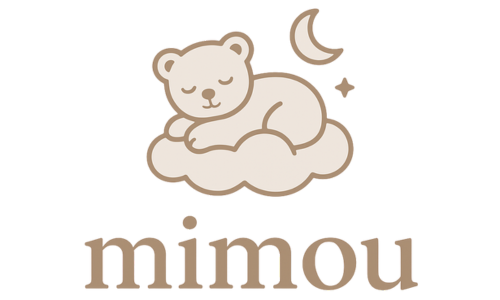Welcome to parenthood! It’s a beautiful, overwhelming, and utterly life-changing new chapter. Stepping into this world can feel like navigating a maze of product recommendations, but I’m here to share a simple truth that will hopefully quiet the noise: you really don’t need everything all at once.
This guide is meant to be a friendly hand on your shoulder, helping you focus on just the essentials for those precious first few weeks. Think of it as your "get-started" kit, designed to cover your baby’s immediate needs for safety and comfort, and give you some much-needed peace of mind.
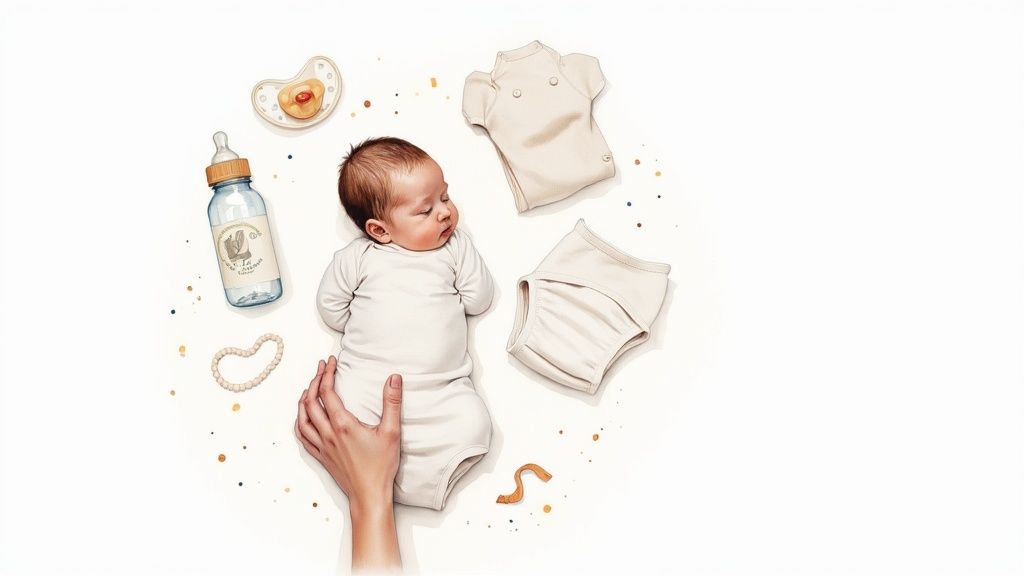
What Really Matters in the Beginning
My philosophy for new parents has always been to prioritize three things above all else: safety, comfort, and practicality. Every suggestion here is based on what your delicate newborn truly needs—soft, breathable fabrics, safe designs, and gear that makes your life easier, not more complicated.
It's easy to get overwhelmed. The baby care market is massive, valued at an estimated $107.6 billion in 2024 and still growing. That number alone shows just how many products are vying for your attention, which is why a simple, curated list is so incredibly helpful.
The real goal isn't to have a Pinterest-perfect nursery overflowing with every gadget imaginable. It's about feeling prepared with the right tools so you can spend less time stressing and more time soaking in every single one of those magical newborn moments.
The Three Pillars of Newborn Life
So, where do you start? Let's break it down. In those first few weeks, your entire world will revolve around three simple, repeating activities. If you focus your energy here, you’ll be ready for just about anything.
Your immediate needs fall into these key categories:
- Feeding: Whether you plan to breastfeed, formula-feed, or a combination of both, having your supplies ready to go is a game-changer.
- Sleeping: A safe and comfortable place for your baby to sleep is absolutely non-negotiable.
- Clothing & Diapering: Keeping your baby clean, dry, and cozy is a 24/7 task. Having the right basics on hand, like the super-soft, baby-safe fabrics in our newborn collection, is essential.
By concentrating on these areas, you’re building a solid foundation. You can always add more things later as you get to know your baby's unique personality and preferences. This approach not only saves you money and reduces clutter but, most importantly, keeps the focus right where it belongs: on you and your brand-new little one.
Your Newborn's First Week Must-Haves Checklist
To make it even simpler, here’s a quick-reference table with the absolute must-haves for that first week at home. Think of this as your "don't leave the hospital without it" list.
| Category | Essential Item | Recommended Quantity (First Week) |
|---|---|---|
| Clothing | Bodysuits (onesies) | 5-7 |
| Sleepers (footie pajamas) | 3-5 | |
| Swaddles | 2-3 | |
| Diapering | Newborn Diapers | 1 pack (approx. 80-100 diapers) |
| Baby Wipes | 1-2 large packs | |
| Diaper Cream | 1 tube | |
| Feeding | Bottles (if using) | 4-6 (4 oz size) |
| Burp Cloths | 5-8 | |
| Nursing Pads/Nipple Cream (if breastfeeding) | 1 box/1 tube | |
| Sleeping | Bassinet or Crib with firm mattress | 1 |
This checklist covers the bare essentials to get you through those early days with confidence. You'll figure out the rest as you go, I promise.
Dressing Your Baby for Comfort and Safety
Let’s be honest, picking out baby clothes is one of the most fun parts of getting ready for your little one. But while you're picturing those adorable tiny outfits, the real keys to a happy baby are comfort, safety, and practicality. A newborn's skin is incredibly sensitive, so choosing the right fabric isn't just a preference—it's essential for their well-being.
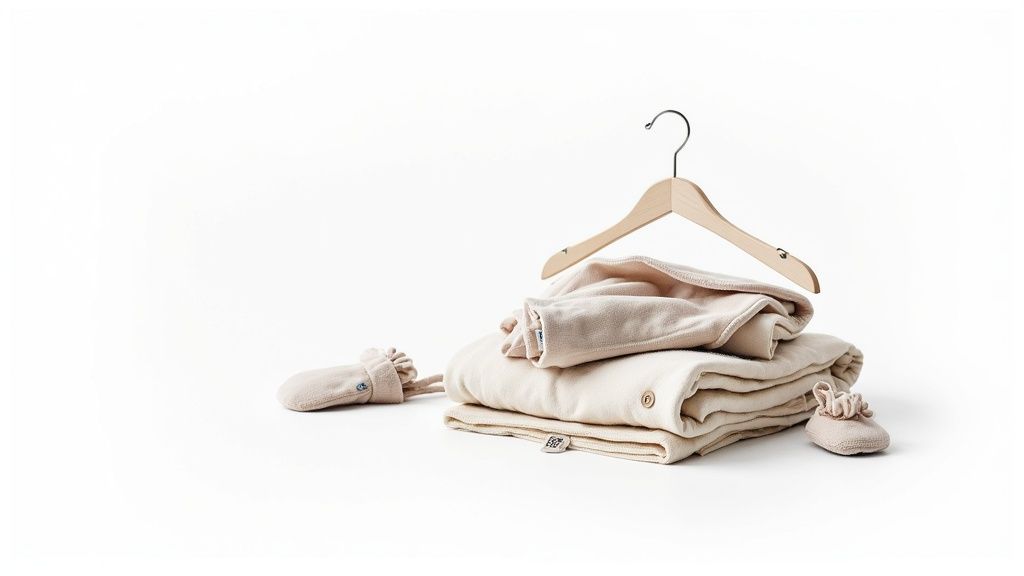
Think of your baby’s first clothes as a second skin. You’re looking for materials that are buttery soft, breathable, and free from anything that might cause irritation. This is exactly why so many parents and pediatricians recommend fabrics like organic cotton. It lets air flow freely, helping to regulate your baby's temperature and preventing overheating or rashes.
The Core Wardrobe Essentials
When you’re first starting out, you don't need a closet bursting at the seams. It's much smarter to focus on a small, hardworking collection of versatile pieces you'll use constantly. This approach not only saves you from laundry overload but also ensures your baby is always wrapped in the good stuff.
Here are the absolute must-haves for those first few months:
- Bodysuits (Onesies): These are the backbone of any baby's wardrobe. Pro-tip: look for ones with "envelope" or "lap" shoulders. Those little folds are a game-changer, letting you pull a messy bodysuit down their body instead of up over their head during a diaper blowout.
- Sleepsuits (Footie Pajamas): These one-and-done outfits are perfect for napping, playing, and everything in between. Trust me, you'll want the ones with zippers. Fumbling with a dozen tiny snaps at 3 a.m. is a new-parent rite of passage you can happily skip.
- Swaddles or Sleep Sacks: Newborns love being swaddled—that snug feeling reminds them of the womb and can be incredibly calming. Once they start showing signs of rolling, a sleep sack becomes a safe, wearable blanket for the crib.
It’s no surprise that baby clothing is a huge market. The global demand for baby products is expected to grow significantly between 2025 and 2033, with essentials like bodysuits hitting peak demand in late summer, specifically August and September.
How Many Clothes Do You Really Need?
This is the million-dollar question for every new parent. It's so easy to go overboard, especially when you remember how fast they grow. A good rule of thumb is to have just enough to get you through a couple of days of spit-up and diaper leaks without having to do laundry every single day.
In the beginning, think function over fashion. You can get by with a surprisingly small number of clothes if you choose wisely. A great starting point is 5-7 bodysuits and 3-5 sleepsuits in both newborn and 0-3 month sizes.
Keep in mind that friends and family will likely shower you with cute outfits as gifts, so it's smart to keep your own shopping list minimal at first. Focus on those practical, high-quality basics, like a pure cotton long-sleeve baby jumpsuit, which offers incredible softness and easy-snap access for quick changes.
Prioritizing Safety in Baby Clothing
Beyond the fabric and fit, nothing is more important than safety. It only takes a second for a loose button or tie to become a hazard, so it pays to be vigilant when you're buying clothes.
Here’s what to look out for on every single piece:
- Avoid Loose Embellishments: Steer clear of anything with buttons, beads, sequins, or little bows that could be pulled off and become a choking hazard.
- Check for Loose Strings or Ties: Any clothing with strings or ties around the neck, like on some hoodies, is a major no-go. They pose a serious strangulation risk.
- Ensure a Snug Fit for Sleep: Sleepwear should always be snug-fitting. This reduces the risk of loose fabric accidentally covering your baby’s face while they sleep. Look for a tag indicating the garment meets federal safety standards for flammability.
By keeping these simple tips in mind, you can build a baby wardrobe that’s not just adorable but also perfectly safe, comfortable, and practical for your new arrival.
Creating a Safe and Soothing Sleep Space
As a new parent, you'll quickly realize that helping your newborn sleep safely and soundly is one of your top missions. Setting up that perfect sleep space can feel like a huge task, but it really boils down to a few simple, evidence-based details. The goal is to create a calming, secure environment that promotes rest while eliminating potential risks.
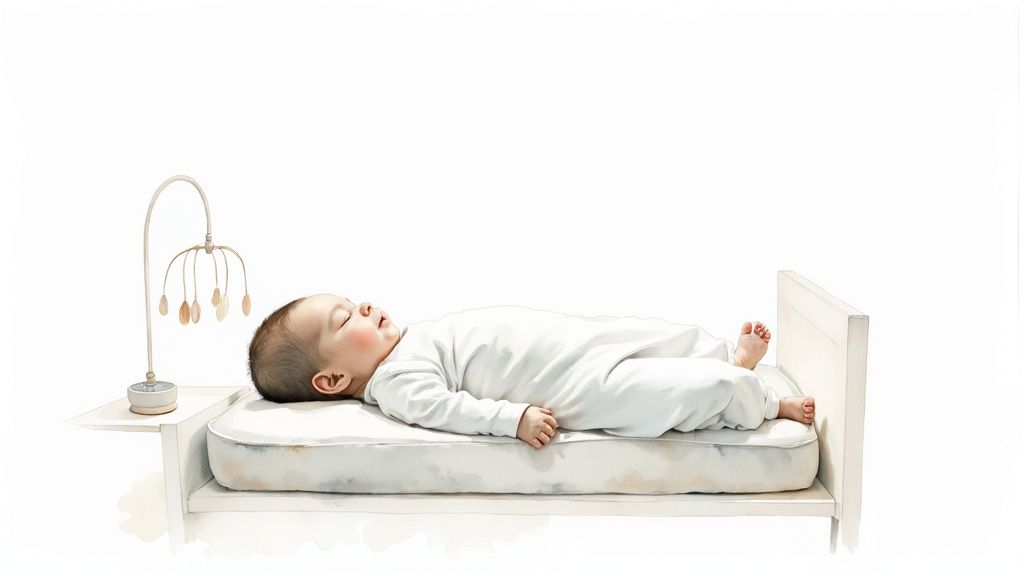
This part of your newborn baby essentials list is all about giving you a clear, no-fuss blueprint for a nursery that’s both soothing and, most importantly, safe. We'll walk through the expert advice so you can feel confident every time you lay your little one down.
When it comes to safe sleep, consistency is everything. The American Academy of Pediatrics (AAP) has clear, research-backed guidelines that are proven to reduce the risk of sleep-related incidents. Following them is the single most important thing you can do.
The core rule is simple but powerful: place your baby on their back for every sleep, on a firm, flat surface, in a crib or bassinet that is completely empty. That means no soft bedding, no bumpers, no pillows, and no stuffed animals.
This "bare is best" approach might look a little stark at first, but it's the absolute gold standard for safety. It ensures your baby's airway stays clear and open all through the night and during every nap.
Choosing the Right Sleep Spot
One of the first big decisions you’ll make is where your baby will actually sleep. The three most common options each have their pros and cons, depending on your living space and what feels right for your family.
Here’s a quick rundown to help you choose:
- Crib: A full-size crib is a fantastic long-term investment that’ll see you through until your little one is ready for a toddler bed. Just make sure it has a firm mattress that fits snugly with no gaps around the edges.
- Bassinet: These are smaller, more portable sleep spots that are perfect for keeping your baby close by in your room for the first few months. Their cozy size can feel more comforting for a tiny newborn.
- Co-Sleeper: Think of this as a special kind of bassinet that attaches securely to the side of your bed. It lets you be right next to your baby while still giving them their own separate, safe sleep surface.
No matter which you pick, the AAP strongly recommends room-sharing (but not bed-sharing) for at least the first six months. Having your baby's crib or bassinet in your room makes those middle-of-the-night feeds so much easier and has been shown to reduce the risk of SIDS by as much as 50%.
Must-Have Sleep Essentials for Comfort and Safety
Once you’ve got the crib or bassinet sorted, a few key items can make things a lot more comfortable without sacrificing safety. These are the practical sleep essentials that truly make a difference in those early months.
A sleep sack is an absolute lifesaver. It’s basically a wearable blanket that zips up, keeping your baby warm and snug without the dangers of loose blankets in the crib. It’s a brilliant invention that delivers total peace of mind.
Another game-changer is a white noise machine. That gentle, constant sound mimics the whooshing noises they heard in the womb, which can be incredibly soothing for a fussy baby and help them drift off to sleep.
It’s also really important to make sure your baby doesn't get too hot while sleeping, as overheating is a known risk factor. A good rule of thumb is to dress them in one light layer more than you're wearing. You can always check the nape of their neck—if it feels sweaty or damp, it's time to remove a layer. For more detailed tips, you can check out our guide on how to tell if your baby is too hot. By focusing on these simple, evidence-based practices, you can create a sleep space that is both comforting and totally secure.
Navigating Feeding and Diaper Duty
Alright, let's talk about the two activities that are about to become your new full-time job: feeding and diapering. This is the heart of newborn life, and while it might sound relentless, you'll fall into a rhythm faster than you think. The real secret? Getting your gear set up before you're in the thick of it.
Think of this part of your newborn baby essentials list as your command center toolkit. We’re going to get you organized and prepared, so you can spend less time scrambling and more time soaking in those newborn snuggles.
Your Guide to Feeding Essentials
How you feed your baby is a deeply personal choice. Breastfeeding, formula-feeding, combo-feeding—there’s no single "right" way to do it. The only goal is a happy, fed baby and a supported, comfortable parent. Having the right tools on hand makes that journey so much smoother.
If you're planning to breastfeed, a few key items can make a world of difference:
- A Nursing Pillow: Honestly, this is a lifesaver for your back. A good U-shaped pillow brings the baby up to you, so you aren't hunched over for hours on end. Your arms, neck, and back will thank you.
- Nursing Pads: Leaks are a totally normal part of the process. Whether you go for disposable or reusable cloth pads, tucking them into your bra keeps you feeling dry and comfortable.
- Nipple Cream: The first few days of breastfeeding can be a learning curve for both of you, and soreness is common. A good lanolin-based or natural nipple cream provides incredible relief and is perfectly safe for your baby.
For parents who are bottle-feeding with formula or pumped milk, here’s what you’ll want ready:
- Bottles: You don’t need a huge stash to start. Grab 4-6 bottles in the smaller, 4-ounce size. Make sure they have slow-flow nipples—these are designed to mimic the natural pace of nursing and help prevent your little one from gulping down too much air.
- Formula: If you know you'll be using formula, have at least one can of your chosen brand at home before you even head to the hospital.
- A Bottle Brush & Drying Rack: Clean bottles are a must. A simple brush designed to get into all the nooks and crannies (especially the nipple!) and a countertop drying rack will make cleanup a breeze.
Setting Up Your Diaper Changing Station
Get ready for it: you'll be changing around 8-12 diapers a day in the beginning. This is why a well-stocked, efficient changing station isn't a luxury—it's a necessity. You don’t need a dedicated changing table, either. The top of a low, sturdy dresser works great, as does a designated spot on the floor.
The golden rule of diaper changes is to have everything you need within arm's reach before you lay the baby down. Never, ever turn your back on a baby on a raised surface, not even for a millisecond.
Your diapering toolkit is beautifully simple:
- Diapers: A big box of newborn-sized diapers is the perfect place to start. A quick pro-tip: the diaper's waistband should sit right below their belly button. If you're seeing constant leaks or little red marks on their thighs, it’s probably time to size up.
- Wipes: Newborn skin is incredibly sensitive, so stick with a large pack of gentle, unscented wipes. The simpler the ingredients, the better.
- Diaper Rash Cream: It's smart to have a tube of zinc oxide cream on hand from day one. Think of it as a preventative tool—a thin layer creates a protective barrier against moisture.
The global market for newborn care products is massive, expected to hit around $50 billion in 2025. That number just goes to show how many gadgets and gizmos are out there, but you truly only need these trusted basics to get started. You can discover more insights about the baby care market and its trends if you're curious!
Remember, you'll become an expert at all of this through practice. Give yourself some grace, keep your stations stocked, and before you know it, you'll be handling feedings and blowouts like a seasoned pro. You've got this.
Getting Out with Your Newborn: Travel and Health Gear
The thought of leaving the house with a brand-new baby can feel like you're planning a multi-day trek. I get it! But trust me, once you have the right gear organized, you'll feel ready to take on anything from a quick doctor's visit to a much-needed stroll in the park. This part of your checklist is all about building that confidence.
Having the right travel and health items isn't just about convenience—it's about peace of mind. When you know you're ready for a sudden diaper blowout or a stuffy nose, you can actually relax and enjoy those first precious outings with your little one.
Safe Travels: Your Guide to Car Seats and Strollers
First things first: you literally can’t leave the hospital without a properly installed infant car seat. This is, without a doubt, the single most important piece of travel gear you will own. It’s a non-negotiable safety item, so it’s worth spending the time to choose the right one and learn how to install it perfectly.
- Infant Car Seats: These are built specifically for newborns and are always rear-facing. The best part? Many can click right into a compatible stroller, creating a "travel system" that lets you move a sleeping baby from the car to the stroller without waking them up. It's a game-changer.
- Convertible Car Seats: These are the bigger guys. They start out rear-facing for newborns and then "convert" to forward-facing as your child grows. While they're a larger investment upfront, they can last for years.
A correctly installed car seat should barely budge—we're talking no more than one inch of movement side-to-side or front-to-back when you pull on it at the belt path. If you want some extra reassurance, find a certified Child Passenger Safety Technician in your area to check your installation.
Once you’ve got the car seat sorted, it's time to think about getting around on foot. A stroller is a lifesaver for walks and running errands. At the same time, a baby carrier offers a wonderfully snug, hands-free way to keep your little one close. Honestly, most parents find they use both for different situations.
Packing the Perfect Diaper Bag
Think of your diaper bag as your mobile command center. The trick is to pack it with everything you might need, without feeling like you're hauling a suitcase around. It’s your "just in case" lifeline.
A well-packed bag should always have:
- Diapering Supplies: Plan on one diaper for every hour you’ll be out, plus a few extras—you can never have too many. Don't forget a travel pack of wipes and a small tube of diaper cream.
- Feeding Essentials: If you're bottle-feeding, bring pre-measured formula and a bottle of clean water, or a pre-made bottle kept cool in a small insulated bag.
- An Extra Outfit: Blowouts and spit-up are a rite of passage! Always have a spare bodysuit or sleeper tucked away.
- A Light Blanket: This is a true multi-tasker. It's perfect for swaddling, using as a nursing cover, or just creating a clean surface to lay your baby down.
Your At-Home Health and Safety Kit
Being ready for minor health hiccups at home can save you so much late-night stress. You don't need to stock a mini-pharmacy, just a few key items to handle common newborn issues calmly.
Your basic kit should have a few essentials. A reliable digital thermometer is crucial for getting an accurate temperature reading. A nasal aspirator (you'll affectionately call it a "snot sucker") is an absolute lifesaver for clearing tiny, stuffy nostrils, especially right before a feed. Finish off your kit with some baby-safe nail clippers or a file to keep those surprisingly sharp little fingernails from scratching their delicate skin.
Your Printable Checklist and Smart Budgeting Tips
Okay, we've gone through a ton of information. Now, let's pull it all together so you can actually use it. This last part is all about getting organized—your shopping list, your registry, and your budget—so you can feel a little more prepared and a lot less overwhelmed. Trust me, feeling organized is a huge win.
To make things super simple, we’ve put together a complete newborn baby essentials list. You can print it out, stick it on the fridge, and check things off as you go. It’s designed to keep you focused on what you really need, steering you away from all those shiny objects in the baby aisle.
Smart Budgeting Where to Splurge and Where to Save
Getting ready for a baby can feel expensive, but it doesn't have to drain your bank account. It’s all about being smart with your money—knowing where to invest in top-tier quality and where it’s perfectly fine to save a few dollars.
A good rule of thumb is to think about longevity and safety. A high-quality car seat, for example, is a non-negotiable. It’s a critical safety item you’ll rely on daily for years. But those adorable newborn-sized outfits? They’ll be outgrown in a flash, making hand-me-downs or budget-friendly basics the smartest move.
One of the most beautiful things about parenthood is the community that surrounds you. Don't be shy about accepting gently used items from trusted friends and family. It’s sustainable, saves money, and is a wonderful way for loved ones to support you.
This visual guide breaks down the essential gear for when you're on the go, highlighting safety and mobility first.
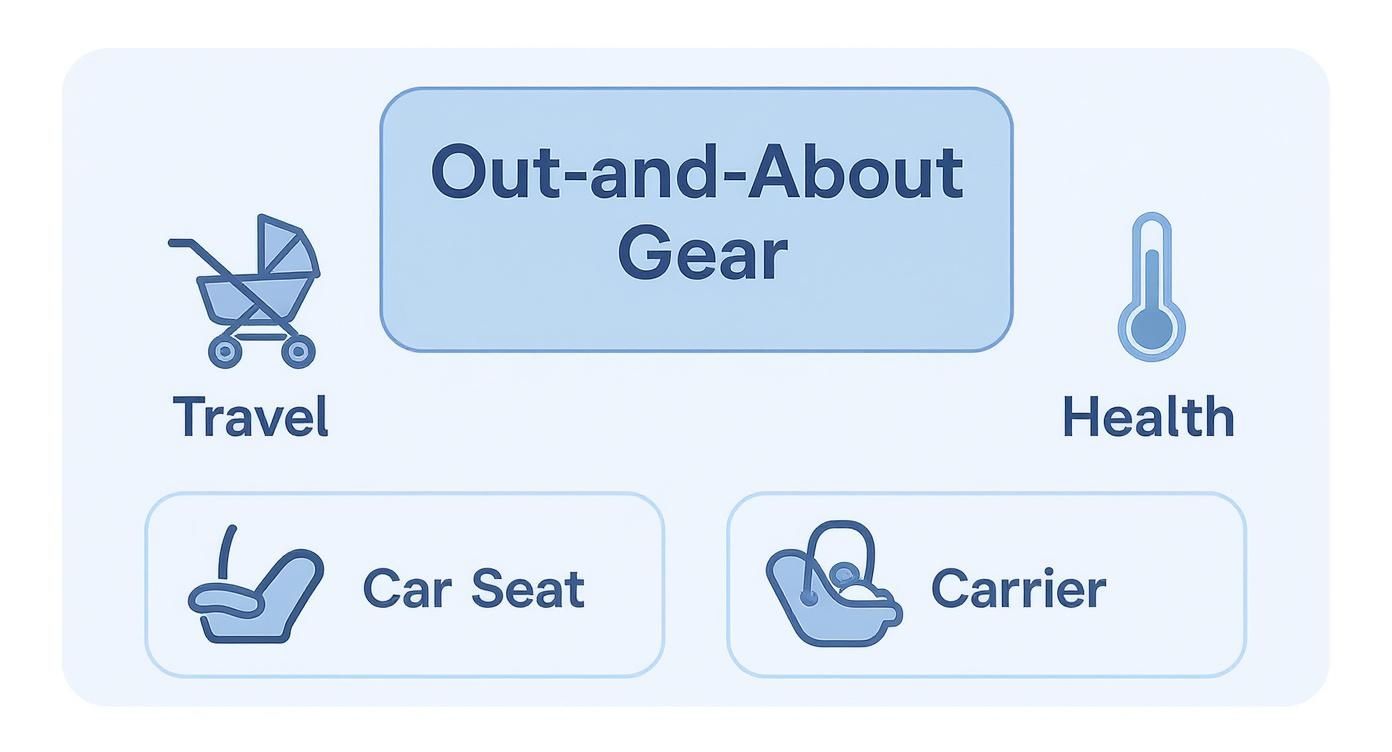
As you can see, items like the car seat and carrier form the foundation of your travel system, while having simple health tools like a thermometer on hand offers invaluable peace of mind.
To help you make these decisions, I've put together a quick guide on where your money is best spent.
Splurge vs. Save A Smart Newborn Budgeting Guide
| Item Category | Recommended to Splurge On (and Why) | Great to Save On (and How) |
|---|---|---|
| Safety Gear | Car Seat & Stroller: These are crucial for safety and daily use. A high-quality, well-reviewed model offers peace of mind and better longevity. | Baby Monitor: You don't need a high-tech video monitor with Wi-Fi and breathing sensors. A reliable audio-only model does the job just fine for a fraction of the price. |
| Nursery | Crib Mattress: Your baby will spend countless hours sleeping. Invest in a firm, breathable, high-quality mattress that supports safe sleep. | Changing Table & Décor: A dedicated changing table is a "nice-to-have." A simple changing pad secured to a low dresser works perfectly. Cute décor can be DIY or thrifted. |
| Feeding | High-Quality Bottles or Breast Pump: If you're pumping or bottle-feeding, reliability is key. A good pump can make all the difference in your feeding journey. | Bottle Sterilizer & Warmer: Your dishwasher's sanitize cycle or a pot of boiling water works perfectly for sterilizing. A mug of warm water can heat a bottle just as well. |
| Clothing | A Few Special Outfits: Go ahead and buy that one adorable "coming home" outfit! It’s a sweet memory to splurge on. | Everyday Basics (Bodysuits, Sleepers): Babies grow so fast and are prone to messes. Opt for multi-packs, budget-friendly brands, and gratefully accept hand-me-downs. |
Ultimately, it’s about making smart choices that work for your family's budget without ever cutting corners on safety.
You Don't Need Everything at Once
Let me leave you with one final, crucial reminder: you do not need every single baby product before your little one arrives. Start with the absolute must-haves for sleeping, eating, and diapering. You’ll figure out the rest as you go, based on what your baby actually needs and what you find works for you.
Remember, the most important thing you can give your baby isn’t on any shopping list. It’s your love, your attention, and your care. The gear just helps make the ride a little smoother. You’re already everything your baby needs. Welcome to this incredible adventure—you’ve got this.
Answering Your Top Questions
If your head is swimming with questions, you're in good company. Every new parent has been there! Let's cut through the noise and tackle some of the most common worries with simple, straight-to-the-point answers.
The idea here is to give you clarity, not more to-do list items. Think of me as that experienced friend who's been through it and can help you feel confident as you get ready for your little one.
How Many Clothes Does a Newborn Actually Need?
This is the big one, isn't it? It’s so easy to get carried away buying adorable tiny outfits, but trust me, they grow at warp speed. Plus, you'll be dealing with more spit-up and diaper blowouts than you can imagine right now.
Here’s a realistic starting point that will see you through the first few weeks:
- 7-10 Bodysuits (Onesies): These will be your go-to, day in and day out.
- 5-7 Sleepers (Footie Pajamas): The perfect uniform for sleeping, cuddling, and just about everything else.
- A few pairs of socks and a couple of soft hats: Crucial for keeping your tiny human warm and cozy.
- 2-3 Swaddles or Sleep Sacks: These are your secret weapon for safe, snug sleep.
This amount is the sweet spot. It gives you enough of a buffer between laundry days without cramming a closet full of clothes they’ll outgrow in a flash.
My best advice? Prioritize function over fashion at first. Focus on soft, easy-to-change pieces. Your friends and family will likely shower you with plenty of those super cute, special-occasion outfits as gifts anyway!
Is a Special Diaper Pail Really Necessary?
Honestly, this comes down to personal preference. A diaper pail is specifically designed to trap odors, which is a major win for some families. But is it an absolute must-have on your newborn baby essentials list? Nope.
Plenty of parents get by just fine with a regular trash can that has a tight lid, as long as they commit to taking the trash out daily. A little trick is to put the really messy diapers in individual disposable bags before tossing them. If your nursery is tiny or right next to your main living space, a dedicated pail might be worth it. Otherwise, feel free to save your money on this one.
When Should I Start Buying the Bigger Stuff?
I know it’s tempting to get everything set up at once, but you can definitely hold off on the big-ticket items. Things like high chairs, jumpers, and big activity centers won't come into play until your baby is older, usually around 4-6 months.
There are real perks to waiting. First, you'll save your home from being cluttered with gear you won't use for months. More importantly, waiting gives you a chance to learn your baby's unique personality and figure out what your family actually needs. You'll make much smarter buys when you're not just guessing. For now, stick to the newborn basics and soak up the simplicity of these early days.
At Mimou Babywear, our mission is to make this new chapter of your life a little softer and simpler. We thoughtfully design our collections with your baby’s comfort and safety as our top priority, using only the gentlest, baby-safe fabrics. From that very first bodysuit to their first wobbly steps, we’re honored to be part of the journey. Explore our curated newborn essentials today.
Article created using Outrank
